Easy Sourdough Starter
This Easy Sourdough Starter recipe creates gorgeously fluffy homemade products such as Sourdough Baguettes. Included are simple step by step instructions on how to start, feed and Maintain Sourdough Starter that is perfect for beginners.
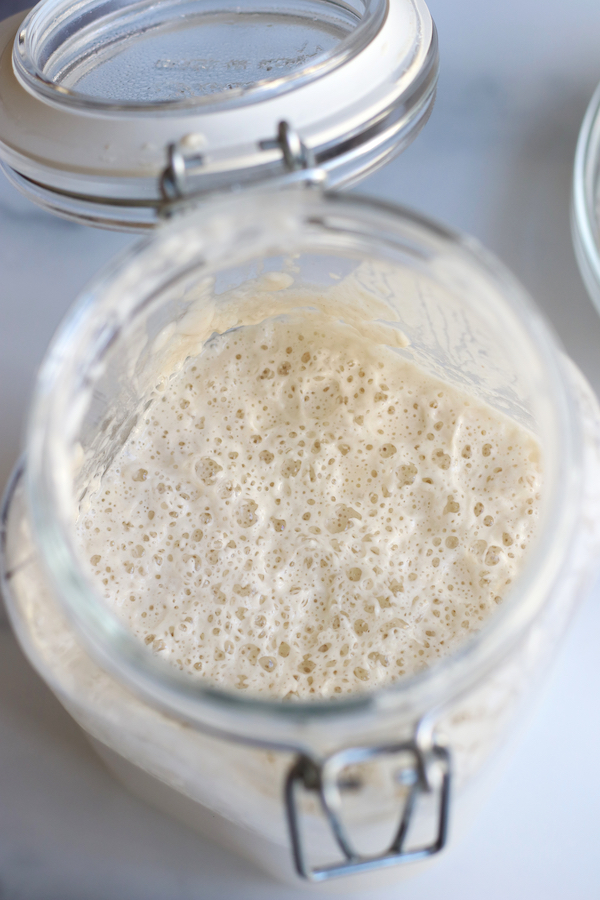
This post may contain affiliate links which I earn a small portion in sales if a purchase is made. Rest assured though, it is never at any additional cost to you.
What is Sourdough Starter
Very simply, sourdough starter is a fermented mixture of two ingredients, water and flour. Wild yeast found in flour flourishes when added to water and is allowed to rest in between feedings. This approach is the old fashioned way of making bread that has been done for centuries. It does require more time than active-dry or instant yeast but produces exceptional taste and textured baked goods.
Tools Needed
In addittion to the flour and water a few tools are needed to make your own from scratch Sourdough Starter.
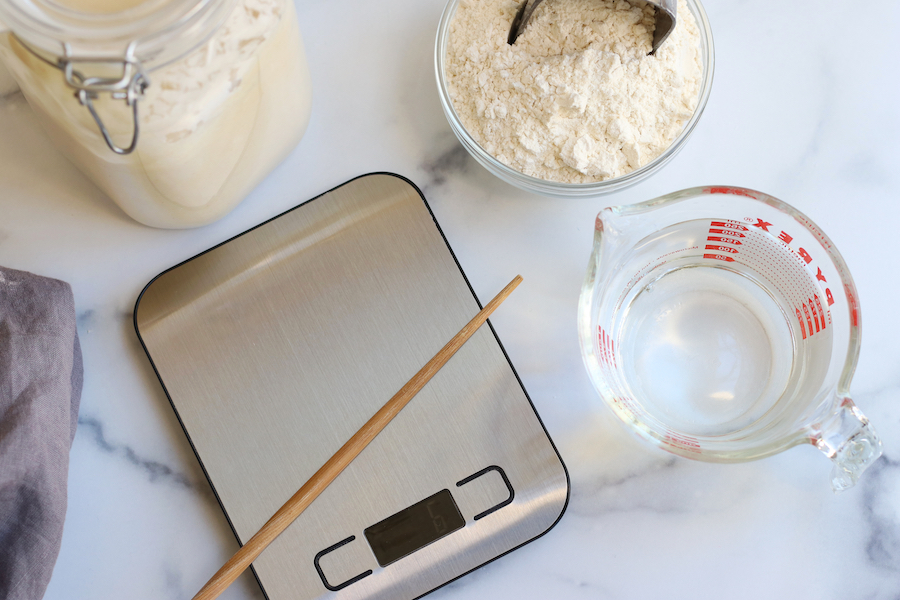
- Kitchen Scale- It is highly encouraged to use a kitchen scale to weigh the flour and water in equals parts to achieve the best results. This is the scale shown in the picture above. However, my next kitchen scale will be a little larger to accommodate the large bowl needed to make sourdough bread.
- Chopsticks– This makes stirring the starter in a glass jar much easier.
- Glass Measuring Cup– Makes for easy pouring of water.
- Scoop or Spoon– Helps with the addittion of flour.
- Medium Sized Glass Bowl– The first few days of a starters life is easier done in a medium size glass bowl.
- Plastic Wrap or Reusable Food Wraps– For the first few days of the starters life.
- Glass Jar (see below)
Sourdough Starter Container
The type of glass jar needed will depend on which type of flour you use to make your starter and how rapidly your starter ferments. This is the jar seen in the photo below and it works beautifully when using white all-purpose flour. Please see section directly below (White Flour vs Wheat Flour) for more explanation.

Best Flour for Sourdough Success
For the best sourdough starter, you need flour you can trust. Buying directly from King Arthur Flour means guaranteed freshness, expert-tested quality, and no risk of warehouse mishandling. Plus, you’ll find exclusive products, better stock availability, and support an employee-owned company dedicated to bakers. Skip the third-party markups and get the best right from the source. You and your sourdough deserve it! (affiliate)
White Flour vs Wheat Flour
The type of flour used will have a great influence on how your Stater ferments and the final product that you make with it. However, it is most important to not choose bleached flour as this will impede the fermentation.
All-Purpose White Flour
I adore sourdough bread that bites me back when I eat it. In other words, extra sour with a tang. However, my husband HATES that kind of bread. That is why I use all-purpose white flour for my Starter.
This type of flour yields breads that are very much like a crusty Italian loaf that he and I both go crazy for. Additionally, I use the Starter from this type of flour for making baguettes that then make incredible Homemade Breadcrumbs and croutons. The final products are never overly sour.
Wheat or Rye Flour
Wheat and rye flour has more naturally occurring wild yeast. Because of this, the starter made from these types of flours will ferment faster and with more intensity. It is very important to keep a closer eye on Starters made from these flours and to use a glass jar that has a lid that is looser or can be left slightly open. The reason for this, a tight fitting lid could be a recipe for an exploding jar.
In conclusion, wheat and rye flours will make much stronger sourdough products and all-purpose white flours (unbleached) will yield more mild final products.
How To Make
To make Sourdough Starter that is ready to bake with will take approximately 7 days, give or take a day or two. Here are the instructions for each day.
Day 1
In a medium sized glass bowl mix together 50 grams of water and 50 grams of flour. Stir well and cover. Let sit at room temperature.
Pro Tip#1– To accurately weigh the flour and water start by making sure the scale is weighing in grams vs ounces. Place the bowl on the scale and turn on. The scale should read zero with the the bowl on top. Add enough flour to equal 50 grams. Calibrate the scale back to zero again and repeat with water.
Pro Tip#2– In the making and feeding of this starter there will always be equal parts of flour and water added to it.
Day 2
To yesterday’s mixture add 50 grams of flour and 50 grams of water. Stir well and cover. Let sit at room temperature.
Day 3
Throw away half of the Starter. To the remaining Starter add 100 grams of flour and 100 grams of water. Stir well and cover. Let sit at room temperature.
Pro Tip#3– The discarded Starter from day 3- day 6 is not fully developed enough to have any uses. Simply throw it away.
Day 4
Throw away half of the starter. Add 150 grams of flour and 150 grams of water to the bowl and stir well. Cover and let sit at room temperature.
Pro Tip#4– Day 4 is the day that you will notice the mixture starting to take on the personality of a Sourdough Starter. There should be small bubbles and a slight sour smell will start to take shape.
Day 5
Similar to the previous days, throw away half of the Starter and add 150 grams of flour and 150 grams of water. Stir well, cover and let sit at room temperature.
Pro Tip#5– The Starter should begin to look very similar to picture A below. If not do not worry, it will very soon. Also, feel free to transfer to the glass jar once the new flour and water its mixed in on day 5.
Day 6
Throw away half of the starter and add 200 grams of flour and 200 grams of water. Stir well, cover and let sit at room temperature.
Pro Tip#6– By day 6 the Starter should look similar to photo A below and very possibly look like photo B.
Day 7
On day 7 the Starter should at the least look like photo B if not like photo C. If it has a similar appearance to photo C, it is ready to use. If it looks like photo B, let it sit at room temperature for one additional day.
Feeding and Reviving Sourdough Starter
Above all, if your Starter looks like photo C it is ready to be used for making all kinds of sourdough products. If it looks like photo B, you can still use it for baking. However, it will slow down the rising of bread dough. When it looks like photo A, it is time to feed the Starter.

To feed the Sourdough Starter, discard half of it and add 150 grams of flour and 150 grams of water to the remaining Starter. Stir well and let sit at room temperature overnight. If on the second day the Starter has the appearance of photo B, let it sit at room temperature for one additional day before using it in recipes.
Pro Tip#7– If storing the Starter at room temperature it will need to be fed every 2-3 days. If storing in the refrigerator, it can be kept safely for up to 10 days before feeding. Please note that if storing in the refrigerator 2 feedings will most likely be needed before the Starter will look like photo C.
Starter Smell and How to Know if it has Gone Bad
A healthy Sourdough Starter is going to smell sour. Therefore, it is not the best way to judge whether it has gone bad. However, the best way to know is by its appearance. If there are any visible signs of mold or red/orange spots it is time to throw the Starter out and begin again. Take heart though, Sourdough Starters are full of good bacteria. Because of this, chances of it going bad are much lower.
Maintaining Sourdough Starter
For anyone new to sourdough baking, it is incredibly normal to have many questions and concerns about maintaining your sourdough starter. How To Maintain Sourdough Starter has a complete breakdown of the feeding schedule, common concerns and questions so that you can enjoy your sourdough starter for decades to come.
If you enjoyed this Sourdough Starter please let me know by leaving a comment and review below. Doing so helps to encourage others to make the recipe also. Thank you!
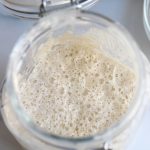
Easy Sourdough Starter
Ingredients
- 700 grams white all-purpose flour *see Note #1 below
- 700 grams filtered water
Instructions
Day 1
- In a medium sized glass bowl mix together 50 grams of water and 50 grams of flour. Stir well and cover. Let sit at room temperature.See Note #2 and Note #3 below.
Day 2
- To yesterday’s mixture add 50 grams of flour and 50 grams of water. Stir well and cover. Let sit at room temperature.
Day 3
- Throw away half of the Starter. To the remaining Starter add 100 grams of flour and 100 grams of water. Stir well and cover. Let sit at room temperature.See Note #3 below.
Day 4
- Throw away half of the starter. Add 150 grams of flour and 150 grams of water to the bowl and stir well. Cover and let sit at room temperature. See Note #4 below.
Day 5
- Similar to the previous days, throw away half of the Starter and add 150 grams of flour and 150 grams of water. Stir well, cover and let sit at room temperature. See Note #5 below.
Day 6
- Throw away half of the starter and add 200 grams of flour and 200 grams of water. Stir well, cover and let sit at room temperature. See Note #6 below.
Day 7
- On day 7 the Starter should at the least look like photo B above if not like photo C. If it has a similar appearance to photo C, it is ready to use. If it looks like photo B, let it sit at room temperature for one additional day.

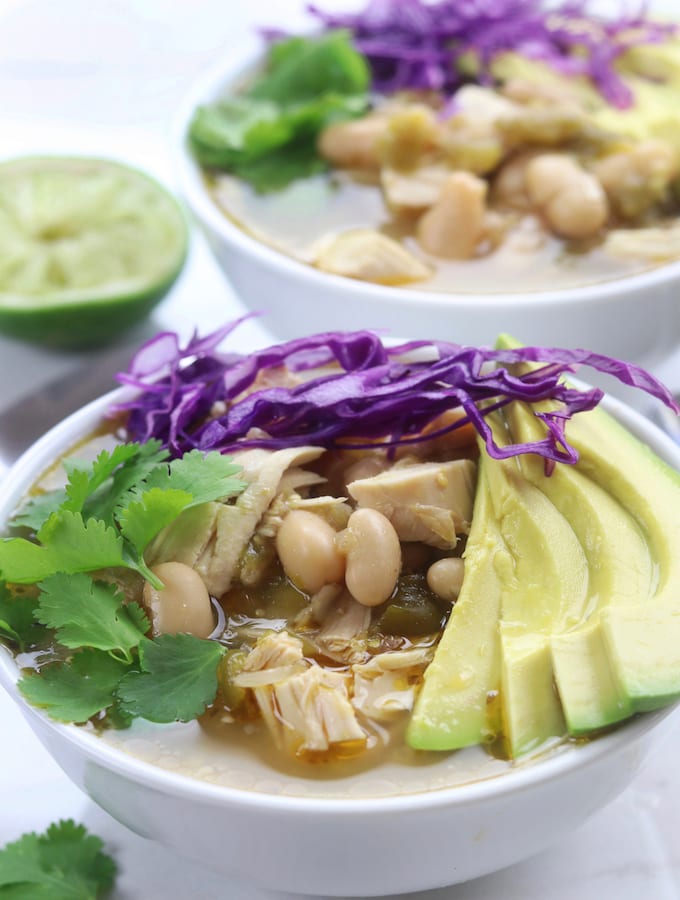

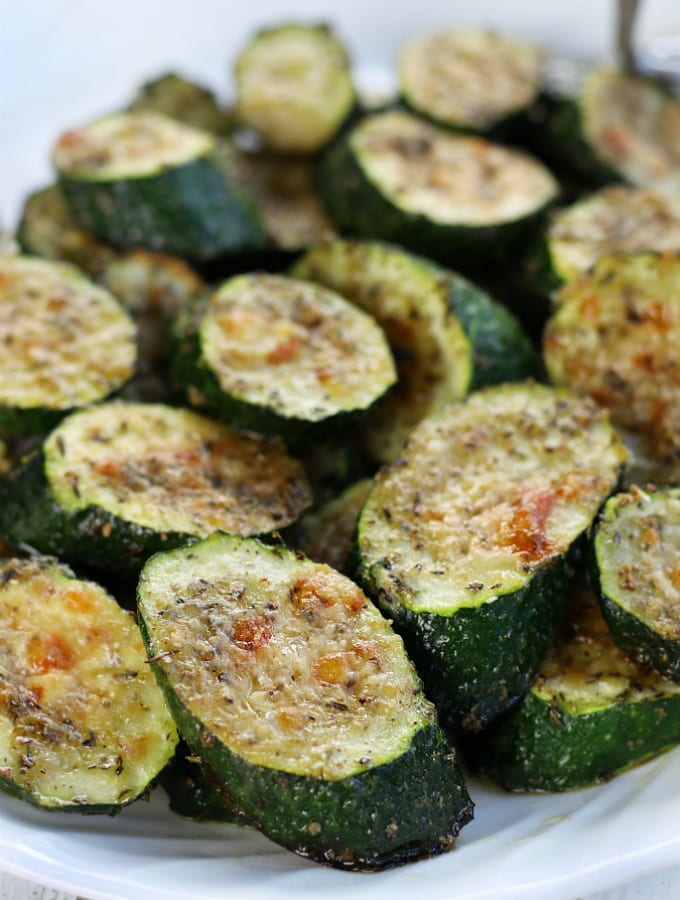



Hi. I’m Courtney and I’m new to this all. Where are the actual instructions for how to bake the bread?
Thank you,
Courtney
Hi Courtney and welcome. Very happy to have you here! Here are two recipes with more on the way this year. https://www.thefedupfoodie.com/sourdough-baguettes/
https://www.thefedupfoodie.com/sourdough-french-bread/
Very helpful content for a beginner with lots of questions! Thank you
You are very welcome. Also, this post goes even deeper into maintaining and troubleshooting. https://www.thefedupfoodie.com/how-to-maintain-sourdough-starter/
hello! i am kind of new to baking breads at home! i have done it a few times in the past, but i was at a lower altitude than im at mow. now that im at a higher altitude i know i have to adjust my baking recipes, but i didnt think my sourdough starter would need adjustments. im on day 7 and it is just barley starting to have some bubbles. any suggestions for me?
Hi Jessica. This is such an important question. Transitioning to a higher altitude can indeed affect your sourdough starter. Since you’re on day 7 and just starting to see some bubbles, it sounds like the lower atmospheric pressure and cooler temperatures at your new altitude might be slowing down fermentation.
To help your sourdough starter along, try maintaining your current feeding schedule but consider using slightly warmer water when feeding it. You may also want to keep your starter in a slightly warmer spot in your kitchen to encourage microbial activity. Be patient and keep an eye on its progress – it should pick up pace soon! Feel free to ask if you have any more questions along the way. Happy baking!
If I want more sourdough flavor how much of whole wheat and rye flour do I use? And when I see recipes citing sourdough discard, does that mean I add sourdough discard from the jar any day after day #7?
Hi Libby. Are you asking if you should add whole wheat flour to the starter or the bread recipe? Depending on which one would depend on how much of each to add.
For recipes using sourdough discard, yes it would be the discard from an already established starter (after day 7).
This post may also be a support for you. It addresses many of the common challenges and questions that come up about maintaining sourdough starter. https://www.thefedupfoodie.com/how-to-maintain-sourdough-starter/
Thank you for the step-by-step recipe! Question: do you measure the half amount you discard in those first seven days or just eyeball it?
Hi Carol. I always eyeball it. I personally feel it’s just too hard to try and measure.
Does the starter half to double in size/ rise before using? I didn’t see anything in the recipe about rising. Thanks!
Hi Jillian. An older more mature starter will double in size. However, it’s not necessary for a younger starter to double in size or rise before using. The focus is more on the development of the starter’s flavor and activity, rather than achieving a specific rise. As long as your starter is active with lots of bubbles and has been fed according to the recipe instructions, it should be ready to use.
Happy baking!
On what day can you start using the start you are throwing away?
Hi Beth. After the first 7 days of developing your starter, you can start using the portion that you would normally discard for sourdough discard recipes. Waiting until after the 7 days will ensure optimal yeast development and flavor.
I hope this helps and please let me know how the recipes go.
My starter is on day 4 and it is looking like picture B and has almost doubled in size. It does also have a slight sour smell. I am wondering if this is normal. I don’t want to jinx myself but it seems to have happened quicker than it should have.
Hi Brittany! It sounds like your starter is off to a great start! Some starter develop quickly. I would go ahead and do the full 7 days before making bread, but it sounds like all is well. Happy baking!
I’m on day7, but it looks like “B”. Do I discard today? How much do I feed it today? It finally doubled overnight.
Hi Paula! It is not unusual to have your starter take 1-2 days longer. From here on out, discard half and then feed it 150 grams of both water and flour. Also, this post may be helpful. Happy baking! https://www.thefedupfoodie.com/how-to-maintain-sourdough-starter/
What happens if I forget to feed my starter on day 5? I completely forgot to discard half and add more flour/water. Not sure if this has ruined the whole process.
Hi Alejandra. Do not worry, you did not ruin it. Just pick up where you left off with the discard and feeding process. At worst, it may take a few more days of discarding and feeding before your starter will be ready to make bread. Keep me updated and please let me know if you have any other questions.
Good morning. I am on day 6 of my starter and it appears to have a water floating on the surface. There are bubbles and a sour smell but the water floating on top is concerning. Thank you for all the valuable information and encouragement to nit give up!
Hi Beverly! Your sourdough starter sounds like it’s on the right track! Don’t worry about the water on the surface—it’s called hooch and indicates your starter needs feeding. Just stir it in and continue with your discard and feeding routine. If you encounter any other hiccups, this post might help you troubleshoot common sourdough challenges. Also, don’t hesitate to reach out with any other questions. Happy baking! https://www.thefedupfoodie.com/how-to-maintain-sourdough-starter/
Hi there! I have a question about storing my starter. I started my starter yesterday, I had planned to leave it on the counter but when I was going to bed I was concerned with it being cold in the house overnight so I put it in the oven with the light on. Now this morning (start of say 2) when I checked on it, it seems to be doing well, it has risen and getting some bubbles, but the bowl was warm to the touch, now Im concerned its too warm in the oven… Can I move it back to the counter or is it best to just stick with 1 storage method?
Thank you so much for all this wonderful information.
Lori
Hi Lori. I’m glad to hear your starter is showing signs of life! It’s normal to adjust where you keep your starter based on the temperature. Since it’s doing well despite the warmth of the oven, you should be fine to move it back to the counter. Just aim for a consistent temperature there.
This post highlights what to keep an eye out for with any challenges but it sounds like you are on your way to some delicious sourdough baking. https://www.thefedupfoodie.com/how-to-maintain-sourdough-starter/
Hi! I fed my starter the day 6 amounts after discarding half. Now 12 hours later it is bubbling beautifully and overflowing my jar. Its huge now. Tomorrow should I discard more than half and feed 150/150 ? I plan to try sourdough tomorrow evening and baking the next day if this makes sense? Also is the discard good to keep now?
Hi Paige, it’s wonderful to hear that your starter is thriving! The overflow you’re experiencing could indicate that your current jar is a bit too snug for its growth. Considering its vigorous expansion, transferring it to a larger jar might the most helpful move. In my recipe post, I’ve included a link to the jar I use, which accommodates a thriving starter beautifully.
Regarding whether to discard more than half, I’m inclined to suggest opting for a larger container or jar rather than discarding a larger portion. This way, you can continue to nurture your starter’s growth without waste.
As for using the discard, you can certainly start incorporating it into recipes right away, especially since your starter is doing so well. It adds fantastic flavor to dishes like pancakes, waffles, or crackers. Keep up the great work and happy baking!
We have tried this recipe for the last week. We get something similar to photo A for day 6, then day 7 it went smooth and almost soupy. What did we do wrong? Can we save it?
Hi Jamie, thank you for trying out the recipe. It’s always challenging when the starter hits bumps in the road. A change in consistency and not seeing progress by day 7 could be due to various factors such as the type of water or flour used, as well as temperature fluctuations. Sourdough starters thrive in a consistent, slightly warm environment. If your kitchen tends to be cold or fluctuates in temperature, finding a warmer spot for your starter might help.
This post goes deeper into troubleshooting and may offer additional support in narrowing down the issue: https://www.thefedupfoodie.com/how-to-maintain-sourdough-starter/
As for saving your current starter, it’s definitely worth a try! You could feed it with equal parts flour and water, discarding any excess if necessary, and see if it bounces back over the next few days. Keep a close eye on it and trust your instincts. If it doesn’t seem to be improving or if there are any concerning changes, it might be time to start fresh.
Please keep me updated on how it goes, and feel free to reach out if you have any further questions or need assistance.
We ended up throwing it out and plan to try again this week – it just didn’t look good. We used all-purpose flour and reverse osmosis water. It was on the kitchen counter, but maybe in need to put it in the pantry or some place else that does have as much traffic or air flow for a more even heat (we are a busy house!)
Hi I have reached day seven and my sourdough looks almost watery like very goopy and jam like. I’m worried I did something wrong, it have all the bubbles and looks and smells like it’s supposed to. I think I accidentally added too much water to flour ratio, what should I do?
Hi Zoey! It sounds like your sourdough starter is active and healthy, despite the texture being more watery than expected. Don’t worry, it’s quite common for starters to vary in consistency based on factors like temperature, flour type, and hydration level. Since it’s bubbling and has a good aroma, it’s likely still on the right track.
To be on the safe side I would suggest proceeding with the discard and feeding process for a few more days and notice if it changes in texture. As long as it continues to rise and develop bubbles, you’re on the right path.
Hi there! Do you feed at the same time each day? Like 24 hours between each feeding? I’m thinking of starting it tonight (currently about 8pm) and I just want to know if I need to plan this time each night until I get the starter going or if I can do “day 2”’s part in the morning.
Hi Monica! Great to hear you’re starting your sourdough journey! Consistency is key with feeding times, but it doesn’t have to be exact to the hour. Aim for roughly 24 hours between feedings, but it’s okay to adjust slightly based on your schedule. I hope this helps and happy baking!
So once it get’s to the “C” picture, it’s like totally ready to use? At that point, I can go find a recipe that calls for active starter and go use the “C” picture in it? What do I do once I’ve used it? Do I feed it again right away or can I put it in the fridge til the next time I’m ready to use it?
Hi Monica! Yes, once your starter is active and bubbly it is ready to make bread. Here are a few sourdough recipes. https://www.thefedupfoodie.com/sourdough-baguettes/
https://www.thefedupfoodie.com/sourdough-french-bread/
As far as how to maintain your starter, you can either refrigerate or leave on the countertop. It really depends on what is the best approach for you. Here is the breakdown on how to maintain your starter. Please let me know if I can help further. https://www.thefedupfoodie.com/how-to-maintain-sourdough-starter/
How large of a clear bowl do I need? Is 1.5 qt large enough?
Hi Mikaela. It will definitely work for the first 3 days. Past that you may need a little bit bigger of a bowl depending on the amount of growth. Please keep me updated. I would love to hear how it goes.
I just wanted to let you know I tried your technique in making a sourdough starter. It was quite simple and no fancy equipment needed. I didn’t do everything such as the glass bowl I use plastic for the first three days. Transferred it to my glass jar and watched it truly grow. I think my mother would be proud of me. Thank you and this new adventure I’m on called sourdough.
That is wonderful to hear Jalene! I hope you have many happy days enjoying homemade sourdough!💛
Can you use the portion you discard to use as a new starter?
Hi Denise. Yes, you absolutely can use to make another starter. This is especially handy when wanting to make one for friends or family.